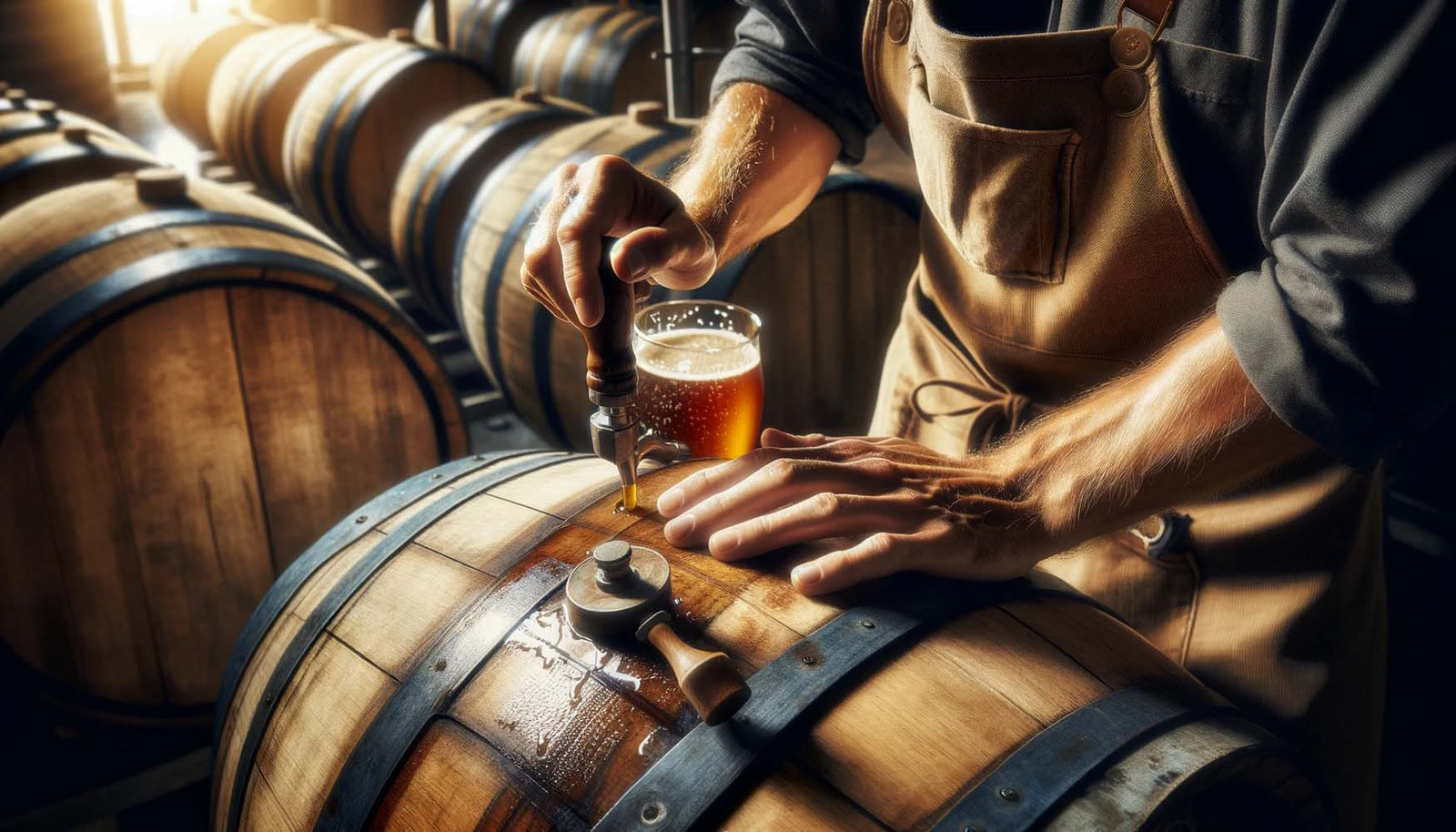
The Art of Barrel Fermentation Beer Brewing: A Guide
February 22, 2024 6 min read
The Art of Barrel Fermentation Beer Brewing: A Guide
Barrel fermentation is a centuries-old method of brewing beer that adds complexity and unique flavors to the final product. In this guide, we will explore the basics of barrel fermentation, the brewing process, the role of yeast, flavor profiling, and troubleshooting common issues.
Understanding the Basics of Barrel Fermentation
Barrel fermentation has a rich history that dates back to ancient civilizations. It was a popular method of storing and fermenting beer before the advent of modern brewing techniques. Understanding the history of barrel fermentation provides insights into its significance and the reasons it is still practiced today.
The science behind fermentation is integral to barrel fermentation. The interaction between the beer and the barrel's wood plays a crucial role in the flavor development process. Oak and other wood varieties contribute different flavors and characteristics to the beer.
When choosing the right barrel for fermentation, there are several factors to consider. Barrel size, age, previous contents, and wood type all impact the final product. Different woods offer distinct flavors, allowing brewers to experiment and create unique beer profiles.
Barrel fermentation is not limited to beer; it is also widely used in winemaking. The use of oak barrels in aging wine dates back centuries and is still a common practice in many wineries around the world. The porous nature of oak allows for slow oxygenation, which can soften tannins and add complexity to the wine.
Aside from flavor enhancement, barrel fermentation can also influence the texture and mouthfeel of the final product. The micro-oxygenation that occurs through the wood can help integrate flavors and create a smoother, more rounded finish. This process is carefully monitored by winemakers and brewers to ensure the desired outcome.
The Process of Barrel Fermentation Beer Brewing
Preparing the barrel for fermentation is an essential step to ensure optimal results. Thorough cleaning and sanitation eliminate any potential contaminants that could affect the final beer. Conditioning and toasting the barrel can also enhance flavor extraction and prevent undesired flavors.
Before the barrel is even considered for fermentation, it is often carefully selected based on the type of wood and its previous use. Different types of wood, such as oak or chestnut, can impart unique flavors to the beer. The previous contents of the barrel, whether it held wine, whiskey, or another spirit, can also influence the final taste profile.
The brewing process itself is quite similar to traditional methods, with a few key differences. After mashing and boiling the ingredients, the wort is transferred to the barrel for fermentation. The barrel's unique environment allows for slow and controlled fermentation, resulting in distinct flavors.
Once the wort is in the barrel, the magic of fermentation begins. The yeast present in the wort consumes the sugars, producing alcohol and carbon dioxide as byproducts. This process can take weeks to months, depending on the desired flavor profile and strength of the beer. Throughout this time, the beer may develop complex flavors from the interaction between the wood and the liquid.
Monitoring the fermentation process is crucial to maintain control over the beer's development. Regular sampling and measuring of gravity and temperature help brewers track fermentation progress and make adjustments if necessary.
The Role of Yeast in Barrel Fermentation
Selecting the right yeast strain is vital for successful barrel fermentation. Different yeasts have varying characteristics, such as temperature tolerance, alcohol tolerance, and flavor profile. Brewers must choose a yeast that complements their desired beer style and aligns with the fermentation conditions.
Yeast plays a significant role in flavor and texture development during barrel fermentation. It interacts with the beer's sugars, producing alcohol and other flavor compounds. This process can result in fruity esters, spicy phenols, and complex flavors that enhance the beer's overall profile.
Furthermore, the choice of yeast can also impact the mouthfeel of the beer. Some yeast strains produce more body and mouthfeel, contributing to a fuller and richer drinking experience. Brewers often experiment with different yeast strains to achieve the desired mouthfeel that complements the flavor profile of the beer.
Moreover, yeast behavior during barrel fermentation is influenced by various factors, including oxygen exposure, barrel material, and aging duration. Oxygen levels can affect yeast metabolism and the production of certain flavor compounds. Additionally, the type of barrel used, whether it's oak, cedar, or another wood variety, can impart unique characteristics to the beer through interactions with the yeast.
The Art of Flavor Profiling in Barrel Fermentation
Barrel fermentation has a significant impact on beer flavor. The wood imparts unique flavors, such as vanilla, coconut, or bourbon, while also contributing tannins and other compounds that affect mouthfeel and structure. The skillful manipulation of these flavor profiles is an art that brewers master over time.
Balancing flavors in barrel-fermented beers requires careful consideration. The combination of barrel notes, yeast contribution, and base beer profile must harmonize without overpowering one another. Brewers carefully blend batches to strike the perfect balance and achieve the intended flavor profile.
One of the key factors influencing flavor development in barrel fermentation is the type of wood used. Different types of wood, such as oak, cherry, or cedar, can impart distinct flavors to the beer. Oak barrels, for example, are prized for their ability to add complex vanilla and caramel notes, while cherry wood barrels may lend a subtle fruity undertone to the brew. Brewers often experiment with various wood types to create unique flavor profiles that set their beers apart.
Furthermore, the duration of aging in barrels plays a crucial role in flavor evolution. Extended aging can intensify the wood-derived flavors and enhance the overall complexity of the beer. Brewers meticulously monitor the aging process, regularly sampling the beer to determine the optimal time for extraction from the barrels. This attention to detail ensures that the flavors develop harmoniously and reach their full potential.
Troubleshooting Common Issues in Barrel Fermentation
Identifying potential problems is essential to maintaining the quality of barrel-fermented beers. Off-flavors, infections, and fermentation stalls can occur, but they are not insurmountable challenges. By closely monitoring the fermentation process, brewers can address issues promptly and implement solutions.
Solutions for common fermentation issues depend on the specific problem. For example, if an infection is detected, the affected barrel should be isolated and cleaned thoroughly. Adjusting temperature, pitching fresh yeast, or oxygenating the beer may be necessary to address other concerns.
Barrel fermentation is an art form that adds complexity and depth to the world of beer brewing. Understanding the history, science, and techniques behind this method allows brewers to explore new flavor territories and create truly unique and memorable beers. By mastering the art of barrel fermentation, brewers can elevate their craft and offer beer enthusiasts a one-of-a-kind taste experience.
One key aspect of successful barrel fermentation is the choice of barrel itself. Different types of wood, such as oak or chestnut, can impart distinct flavors and characteristics to the beer. The age and previous use of the barrel also play a significant role in influencing the final product. Brewers often experiment with various barrel types to achieve the desired flavor profile, leading to a diverse range of barrel-fermented beers in the market.
Furthermore, the length of time the beer spends in the barrel is crucial for developing complex flavors. Extended aging allows the beer to interact with the wood, absorbing tannins, vanillin, and other compounds that contribute to its overall taste. This patient process of maturation is a labor of love for brewers, requiring careful monitoring and periodic tasting to determine the optimal moment for bottling or blending.
Ready to take your barrel fermentation adventures to the next level? Bräu Supply is here to support your brewing journey with our innovative Unibräu systems, including the all-in-one Unibräu Pro and our efficient HERMS setup. Our high-quality 304 stainless steel brew kettles and Unitank jacketed fermenters are designed with modularity and electric brewing efficiency in mind. With the most available accessories in the business, our products offer unparalleled value and quality, ensuring you have everything you need for a successful brew day. Whether you're a seasoned brewer or just starting out, our systems make brewing complex, barrel-fermented beers more accessible and enjoyable. Check out our products and start crafting your unique beer creations today!
MORE ARTICLES HOW TO BREW BEER
The ultimate guide to Kveik yeast: Unleashing it's fermentation potential
Revolutionizing home brewing: The simplified art of no sparge brewing
Exploring amber ales: A guide with a twist on the traditional recipe
Mastering cold crashing: Enhancing beer clarity and accelerating the aging process
What is the basic function of the fermenter?
What causes a fermenter to heat up?
The art of lagering: A guide to perfecting the cold conditioning process
Troubleshooting fermentation problems in brewing: A comprehensive guide
Subscribe
Sign up to get the latest on sales, new releases and more …


